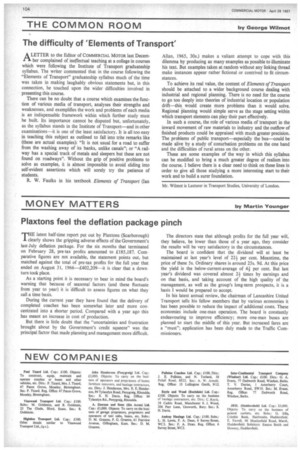THE COMMON ROOM by George Wilmot
Page 106

If you've noticed an error in this article please click here to report it so we can fix it.
The difficulty of 'Elements of Transport'
ALETTER to the Editor of COMMERCIAL MOTOR last December complained of ineffectual teaching at a college in courses which were following the Institute of Transport graduateship syllabus. The writer commented that in the course following the "Elements of Transport" graduateship syllabus much of the time was taken in making laughably obvious statements but, in this connection, he touched upon the wider difficulties involved in presenting this course.
There can be no doubt that a course which examines the function of various media of transport, analyses their strengths and weaknesses, and exemplifies the work and problems of each media is an indispensable framework within which further study must be built. Its importance cannot be disputed but, unfortunately, as the syllabus stands in the Institute of Transport—and in other examinations—it is one of the least satisfactory. It is all too easy in teaching this subject as outlined to fall into trite remarks like (these are actual examples): "It is not usual for a road to suffer from the washing away of its banks, unlike canals"; or "A railway has a special track of metals and sleepers but these are not found on roadways". Without the grip of positive problems to solve as examples, it is almost impossible to avoid sliding into self-evident assertions which will sorely try the patience of students.
R. W. Faulks in his textbook Elements of Transport (Ian
Allan, 1965, 30s.) makes a valiant attempt to cope with this dilemma by producing as many examples as possible to illuminate his text. But examples taken at random without any linking thread make instances appear rather fictional or contrived to fit circumstances.
To achieve its real value, the content of Elements of Transport should be attached to a wider background course dealing with industrial and regional planning. There is no need for the course to go too deeply into theories of industrial location or population drift—this would create more problems than it would solve. Regional planning would simple serve as the stage setting within which transport elements can play their part effectively.
In such a course, the role of various media of transport in the inward movement of raw materials to industry and the outflow of finished products could be appraised with much greater precision. The problems of public transport—especially the bus—could be made alive by a study of conurbation problems on the one hand and the difficulties of rural areas on the other.
These are some examples of the way in which this syllabus can be modified to bring a much greater degree of realism into the course. I believe there is a clear need to think on these lines in order to give all those studying a more interesting start to their work and to build a surer foundation.
















































































































































































